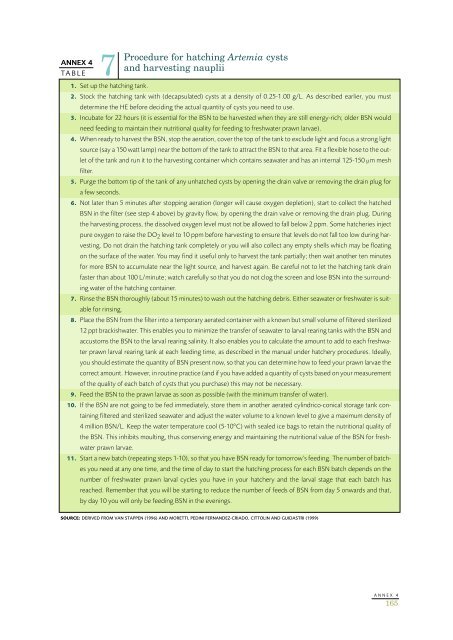Create successful ePaper yourself
Turn your PDF publications into a flip-book with our unique Google optimized e-Paper software.
7ANNEX 4TABLE1. Set up the hatching tank.Procedure for hatching Artemia cystsand harvesting nauplii2. Stock the hatching tank with (decapsulated) cysts at a density of 0.25-1.00 g/L. As described earlier, you mustdetermine the HE before deciding the actual quantity of cysts you need to use.3. Incubate for 22 hours (it is essential for the BSN to be harvested when they are still energy-rich; older BSN wouldneed feeding to maintain their nutritional quality for feeding to <strong>freshwater</strong> prawn larvae).4. When ready to harvest the BSN, stop the aeration, cover the top of the tank to exclude light and focus a strong lightsource (say a 150 watt lamp) near the bottom of the tank to attract the BSN to that area. Fit a flexible hose to the outletof the tank and run it to the harvesting container which contains seawater and has an internal 125-150 µm meshfilter.5. Purge the bottom tip of the tank of any unhatched cysts by opening the drain valve or removing the drain plug fora few seconds.6. Not later than 5 minutes after stopping aeration (longer will cause oxygen depletion), start to collect the hatchedBSN in the filter (see step 4 above) by gravity flow, by opening the drain valve or removing the drain plug. Duringthe harvesting process, the dissolved oxygen level must not be allowed to fall below 2 ppm. Some hatcheries injectpure oxygen to raise the DO 2 level to 10 ppm before harvesting to ensure that levels do not fall too low during harvesting.Do not drain the hatching tank completely or you will also collect any empty shells which may be floatingon the surface of the water. You may find it useful only to harvest the tank partially; then wait another ten minutesfor more BSN to accumulate near the light source, and harvest again. Be careful not to let the hatching tank drainfaster than about 100 L/minute; watch carefully so that you do not clog the screen and lose BSN into the surroundingwater of the hatching container.7. Rinse the BSN thoroughly (about 15 minutes) to wash out the hatching debris. Either seawater or <strong>freshwater</strong> is suitablefor rinsing.8. Place the BSN from the filter into a temporary aerated container with a known but small volume of filtered sterilized12 ppt brackishwater. This enables you to minimize the transfer of seawater to larval rearing tanks with the BSN andaccustoms the BSN to the larval rearing salinity. It also enables you to calculate the amount to add to each <strong>freshwater</strong>prawn larval rearing tank at each feeding time, as described in the manual under hatchery procedures. Ideally,you should estimate the quantity of BSN present now, so that you can determine how to feed your prawn larvae thecorrect amount. However, in routine practice (and if you have added a quantity of cysts based on your measurementof the quality of each batch of cysts that you purchase) this may not be necessary.9. Feed the BSN to the prawn larvae as soon as possible (with the minimum transfer of water).10. If the BSN are not going to be fed immediately, store them in another aerated cylindrico-conical storage tank containingfiltered and sterilized seawater and adjust the water volume to a known level to give a maximum density of4 million BSN/L. Keep the water temperature cool (5-10°C) with sealed ice bags to retain the nutritional quality ofthe BSN. This inhibits moulting, thus conserving energy and maintaining the nutritional value of the BSN for <strong>freshwater</strong>prawn larvae.11. Start a new batch (repeating steps 1-10), so that you have BSN ready for tomorrow’s feeding. The number of batchesyou need at any one time, and the time of day to start the hatching process for each BSN batch depends on thenumber of <strong>freshwater</strong> prawn larval cycles you have in your hatchery and the larval stage that each batch hasreached. Remember that you will be starting to reduce the number of feeds of BSN from day 5 onwards and that,by day 10 you will only be feeding BSN in the evenings.SOURCE: DERIVED FROM VAN STAPPEN (1996) AND MORETTI, PEDINI FERNANDEZ-CRIADO, CITTOLIN AND GUIDASTRI (1999)ANNEX 4165
















